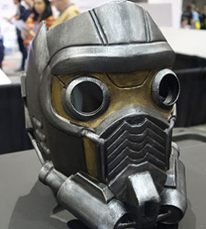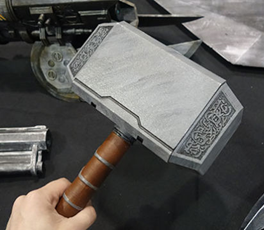The moviemaking industry is facing radical changes as a result of the recent growth in Netflix, Amazon, and other online streaming services. At the same time, movie production costs are staggering and unprecedented resulting from the onslaught of visual effects and rising popularity of fantasy films. On average, visual effects cost $25 million per picture and recent shooting in 3D adds $15 million to overall expenditures. Viewers want to see unbelievable and unrealistic portrayals of alternate realities—all of which require advanced effects, props, sound, and graphics. Since technology is constantly changing, “every director wants ‘never before seen’ so by definition a quarter of the shots if not more are going to be new and must be developed from scratch.” Aside from advanced technology, computer programming, and superior 3D visual effects software, movie production teams are beginning to 3D print props that are more accurate, realistic, detailed, and customizable to different scenes and purposes. As a result of this new application of 3D printing, movie studios engaging in 3D printing props are eligible for R&D federal and state tax credits.
The Research & Development Tax Credit
Enacted in 1981, the federal Research and Development (R&D) Tax Credit allows a credit of up to 13% of eligible spending for new and improved products and processes. Qualified research must meet the following four criteria:
- New or improved products, processes, or software
- Technological in nature
- Elimination of uncertainty
- Process of experimentation
Eligible costs include employee wages, cost of supplies, cost of testing, contract research expenses, and costs associated with developing a patent. On December 18, 2015, President Obama signed the bill making the R&D Tax Credit permanent. Beginning in 2016, the R&D credit can be used to offset Alternative Minimum tax and startup businesses can utilize the credit against $250,000 per year in payroll taxes.
The Future of Film
There was a time when futuristic movies portrayed a fantasy about printing any object an individual desired. Now, reality is caught up since production teams in movie studios resort to 3D print props. It is estimated that movie studios spend more than $100 million per year on computer-generated special effects. This includes 3D printing. Competition in the industry is also at an all-time high, which motivates the effects houses to explore other avenues for revenue in the form of 3D printing. As a result, there are fewer limitations in designing, prototyping, and producing the final props. The only significant limit is the client’s budget, which even then, carries more value than with traditional, manmade prop creation.
When Fantasy Becomes Reality
New Zealand’s Weta Workshop offers design and manufacturing services for the film industry. It is credited with many major blockbusters, including The Lord of the Rings franchise, Hercules, King Kong, and Indiana Jones. Most notably, it created props and set pieces for The Hobbit series. Before 3D printing, this workshop made props by hand for The Lord of the Rings movies. In The Hobbit, An Unexpected Journey, “90% of the animatronics responsible for moving goblin eyeballs, facial muscles, lips, and tongues on set came from Weta’s fleet of 3D printers.” The benefits of 3D printing are evident in the success of Weta Workshop’s projects. For example, a 3D printed eye mechanism costs only $50 to print and one day to complete. Making this same mechanism by hand would take upwards of 2 weeks and cost significantly more. The company employs the most cutting edge high-tech 3D milling, printing, and laser cutting technology to create different types of armor, plates and chainmail, shields, weapons, vehicles, and sci-fi and mechanical props. Furthermore, they employ bronze casting and 3D design technology to create an array of 3D display pieces.
 California-based Legacy Effects used 3D printing in designing and building Iron Man’s armor in Iron Man and Avengers. The same digital file was used to create the life-size armor plates for the actor, but also smaller scale models for light tests and resolving potential issues that may arise when the actors come on set. At that time, they were the first studio to experiment with 3D printing an entire costume. This company began exploring 3D printing after it was tasked with creating a miniature 3D model of a fight scene from Halo 3. Traditional sculpting did not allow the team to produce enough detail and figurines in the allotted timeframe. In fact, prototypes were most often sculpted out of clay and took days to accomplish one iteration. In the film industry, a special effects studio is lucky if it has 4-6 weeks for the entire project from start to end date. With 3D printing, studios like Legacy Effects can submit concept designs digitally and get them approved within a day. One of the most beneficial aspects that Legacy Effects notes about 3D printing is that joints and mechanics of movement are incorporated into the designing stage, which saves time during prop development and testing. Thus, it offers solutions to issues that traditional approaches could not answer. To put it into perspective, Legacy Effects produced 26 full-size robot suits from 3D printing in the same amount of time as it would take them to sculpt one model from clay.
California-based Legacy Effects used 3D printing in designing and building Iron Man’s armor in Iron Man and Avengers. The same digital file was used to create the life-size armor plates for the actor, but also smaller scale models for light tests and resolving potential issues that may arise when the actors come on set. At that time, they were the first studio to experiment with 3D printing an entire costume. This company began exploring 3D printing after it was tasked with creating a miniature 3D model of a fight scene from Halo 3. Traditional sculpting did not allow the team to produce enough detail and figurines in the allotted timeframe. In fact, prototypes were most often sculpted out of clay and took days to accomplish one iteration. In the film industry, a special effects studio is lucky if it has 4-6 weeks for the entire project from start to end date. With 3D printing, studios like Legacy Effects can submit concept designs digitally and get them approved within a day. One of the most beneficial aspects that Legacy Effects notes about 3D printing is that joints and mechanics of movement are incorporated into the designing stage, which saves time during prop development and testing. Thus, it offers solutions to issues that traditional approaches could not answer. To put it into perspective, Legacy Effects produced 26 full-size robot suits from 3D printing in the same amount of time as it would take them to sculpt one model from clay.
Prop Shop, based in the UK, is another company that 3D prints props for various movies. The company worked with Guardians of the Galaxy to 3D model and print weapons as well as parts of the ships. Prop Shop works uniquely in that “everything we do is 100% digital. We can scan something, model it, and then print it as a prop.” They currently utilize technology to scan actors and existing props. The scans are beneficial in pre-production to plan shots, action sequences, and lighting. Prop Shop created many 3D printed props. In Zero Dark Thirty, night-vision goggles were 3D printed with aluminum, because the original ones cost $60,000 per unit and the Department of Defense did not want to release them. The printed ones were designed off leaked photos of the real goggles. In the same film, the Merlin helicopter’s rotor and landing gear were printed to then be used in explosion scenes that needed to be filmed more than once. In Maleficent, one of the Friesian horses was scanned so the team could model and build horse armor via computer software. They printed the armor and fit it perfectly to the horse, which would not have been as feasible since the horse is a difficult subject to keep still. Finally, in Thor, 3D printing was used to create different versions of the same hammer for varying purposes. The combat scenes relied on a rubber cast of the model to make it easier to wield, whereas the hammer that was carried around on a frequent basis was made of heavier material.
The Game of Thrones Dragons are Real
The HBO Game of Thrones franchise is one of the leading users of 3D printed props in the film industry. They use Laser Prototypes Europe Ltd., based in Northern Ireland. Laser Prototypes supplies most of the armor, masks, jewelry, and weapons seen in each season. The company prides itself on this faster way to create props that are lightweight and realistic. 3D printing has a profound impact on the film industry, since visual effects teams can draw up free-form props that are otherwise more challenging to design and manufacture via traditional methods. The strangest prop request from Game of Thrones was to build a large-scale printed dragon. The most common prop made was the Sons of the Harpy masks.
3D printing allows Laser Prototypes to build almost any prop imaginable without being concerned with design, weight, and quality constraints. There was a time when blockbuster actors and actresses were wearing armor of metal or lugging weapons of steel for intensive combat scenes. Now, with the advent of 3D printing, plastics mimic the clarity in detail and texture without burdening actors and actresses employing the props. Laser Prototypes is also creating 3D printed props for X-Men as well as uniforms in the upcoming 2019 Star Wars: Episode IX film.
Conclusion
Now that movie studios move towards 3D printing of digital effects and props, it appears as a reversal of the traditional workflow in which physical models were scanned into a computer program to be used in background effects and imagery. Studios are grappling with a new, competitive nature of the film industry and how viewers anticipate more realistic representations of supernatural and fantastical storylines. Those studios engaging in 3D printing efforts of film props are now eligible for R&D federal and state tax credits. This also incentivizes film studios striving to distinguish themselves in this competitive market to find successful alternatives in 3D prop printing.
Charles Goulding and Chloe Margulis of R&D Tax Savers discuss 3D printing in the filmmaking industry.
Subscribe to Our Email Newsletter
Stay up-to-date on all the latest news from the 3D printing industry and receive information and offers from third party vendors.
You May Also Like
Meltio Expands Global Reach with New Partnerships in the Americas and Europe
Spanish 3D printing manufacturer Meltio has expanded its sales network across the globe. With the addition of three new partners in the United States, Brazil, Argentina, and Italy, Meltio aims...
3D Printing Webinar and Event Roundup: April 7, 2024
Webinars and events in the 3D printing industry are picking back up this week! Sea-Air-Space is coming to Maryland, and SAE International is sponsoring a 3D Systems webinar about 3D...
On the Ground in Linares, Spain for the Meltio M600 Launch
As detailed in a previous post, metal 3D printer manufacturer Meltio launched its latest wire-laser metal deposition (LMD) machine, the Meltio M600, at its headquarters in Linares, Spain. There, I was...
Blue Laser-powered M600 3D Printer Launched by Meltio
Founded in 2019 as a joint venture between Additec and Sicnova, metal 3D printer OEM Meltio develops and manufactures high-performance and easy-to-use metal 3D printing solutions that use its patented wire-laser metal...



































